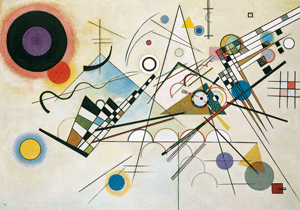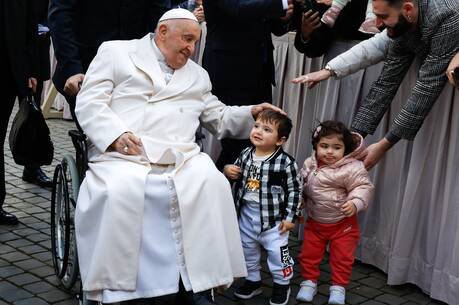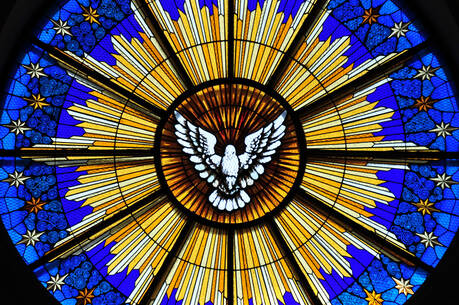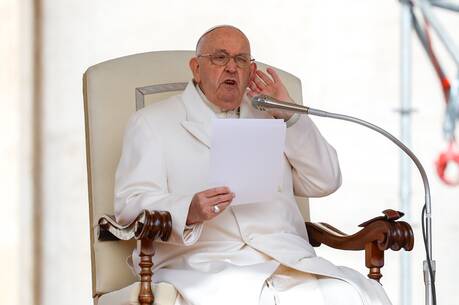The Russian-born artist Vasily Kandinsky believed his time was one of spiritual crisis. “The nightmare of materialism…[has] turned life into an evil, senseless game,” he wrote, and Western culture “awakening after years of materialism [is] infected with the despair born of unbelief, of lack of purpose and aim.” With religion, science and morality unmoored, an increasing number of people distrusted the adequacy of science to answer deeper questions, Kandinsky believed, and so they had begun to seek “inner knowledge.”
Sound familiar? The diagnosis comes from Kandinsky’s book On the Spiritual in Art, written in 1911 in tones at once prophetic and poetic. “Literature, music and art are the most sensitive spheres in which this spiritual revolution makes itself felt,” he wrote, envisioning spiritual regeneration through the arts.
For the first 30 years of Kandinsky’s life, these views would have seemed improbable to his family and friends. Born in Moscow into a prosperous family, Kandinsky enrolled at 19 in the University of Moscow to study law, economics and statistics. In 1892 he married his cousin Anja, graduated from the university and began doctoral work in economics, but abandoned it two years later. Two major experiences in 1896 affected him deeply: seeing one of the paintings in Monet’s “Haystacks” series and hearing a performance of Wagner’s “Lohengrin.” For the rest of his life Kandinsky pursued the goal of a pictorial art that would resemble music, which he considered the greatest and most abstract of the arts—“the best teacher,” he called it.
“Every work of art is a child of its time,” Kandinsky wrote. And of its place as well, he might have added. The splendid “Kandinsky” exhibition now at the Solomon R. Guggenheim Museum in New York (through Jan. 13), which includes several extraordinary loans, highlights the places where the artist lived.
Kandinsky moved with Anja to Munich in 1896 to study painting. Within five years he helped to establish the Phalanx artists’ association. While teaching there, he became close to one of his young students, Gabriele Münter, for whom he left his wife in 1904. The earliest pictures shown here are quick plein-air sketches documenting his travels with Münter through Europe and Tunisia. They settled for a year in Paris, where his work culminated in “Colorful Life” (1907), a nostalgic recreation of medieval Russia. The painting’s stippled brush strokes and brilliant colors recall the Neo-Impressionist and Fauve artists Kandinsky had seen in Paris.
Returning to Munich in 1908, Kandinsky and Münter took an apartment in Schwabing and discovered the village of Murnau in the foothills of the Bavarian Alps. Kandinsky’s Murnau scenes, generally realistic but increasingly abstract, show a childlike, lyrical freedom with color and composition. Billowing white clouds over rolling hills in “Landscape Near Murnau With a Locomotive” (1909) would be cartoonish if they did not sing so. And the Guggenheim’s famous “Blue Mountain” (1908-9) melodically combines the chivalry of its three riders on horseback—Kandinsky’s recurrent symbol for artistic courage and innovation—with a canticle to nature that burns with gemlike color.
Gradually Kandinsky’s style became less representational and fell into three categories that he distinguished by their association with music: “impressions,” based on real-life subjects; “improvisations,” drawn on spontaneous and unconscious images from his inner life; and “compositions,” based on multiple previous studies. As his work became more visionary, dark hints of cataclysmic and even apocalyptic events emerged.
When you come upon “Picture With a Circle” (1911) from the Georgian National Museum in Tbilisi and exhibited for the first time in the United States, the round forms delineated only by color, with black lines whiplashing through neighboring mists of rainbow tones, simply astound—like a vision of creation. (“The creation of the work of art is the creation of the world,” the artist wrote in his Reminiscences of 1913.) Still more powerful is the “Painting With a Black Arch” (1912) in which an initiate may see the arc as recalling part of a horse’s harness, though anyone can revel in the harmony of form and color.
The climax of this fertile period in the artist’s life, and for me the high point of the entire exhibition, is the set of four panels commissioned by Edwin R. Campbell for the foyer of his Park Avenue apartment in New York. Sometimes interpreted as a four-seasons suite, the canvases are better read as pure abstraction, miraculously combining balance and movement, a riotous range of color with each tone retaining its value, forms defying definition and lines springing as if from nowhere and ending as suddenly. A sense of upward movement prevails: Might not this weightless world float at any minute into the sky? There is no illusionist or perspectival space, but there is a sense of depth, as cool colors recede and warm ones move toward you. Symphonic is not too great a word for this marvelous wall.
With the outbreak of World War I, Kandinsky left Germany and made his way through Switzerland back to Moscow. Uprooted, and his relationship with Münter unraveling, he found it difficult to paint and so worked mostly on paper. In 1917, he married Nina Andreevskaya. After the October Revolution, the state expropriated the apartment building Kandinsky had inherited, and the family often went hungry and cold. Their only son died at the age of 2. The work of two artists then dominant in Russia made the spiritual, intuitive Kandinsky increasingly uncomfortable: the strict geometrism of Kazimir Malevich’s Suprematism and the mechanical utilitarianism of Vladimir Tatlin’s Constructivism. But Kandinsky still managed to create memorable canvases like “Moscow I” of (1916), a small, celebratory and surprisingly representational depiction of the city he had always called home [see cover], and “Overcast” (1917), a turbulent collision of intensely colored forms, large and small, with a typical contrast of threatening darkness and promising light.
Shortly after Kandinsky and Nina moved to Berlin in 1921, the architect Walter Gropius invited him to Weimar to teach at the Bauhaus. The next 11 years were happier and more productive for him, even though the school’s geometric and rationalist functionalism also tended to constrain his expressive nature. Teaching, organizing exhibitions and writing, the artist enjoyed the collegial atmosphere and especially his reunion with his old friend Paul Klee. (In the superb collection of 60 works on paper that accompanies the exhibition, the first wall has a series of Kandinsky watercolors that might well have been by Klee.)
When Solomon R. Guggenheim and his wife, Irene, accompanied by his art advisor Hilla Rebay, visited Kandinsky in 1930 at the Bauhaus’s new location in Dessau, he bought four works from the artist, including “Composition 8” (1923) [see p. 19]. (Ultimately, Guggenheim would buy over 1,500 of the painter’s works.) Standing before the painting today, you can almost sense the triumph Kandinsky must have felt on completing this cosmic vision. Here geometry has become musical, playing across the canvas from lower left to upper right, from bottom to top. A black, eclipse-like circle in the upper left corner echoes the apocalyptic hints of Munich and the severity of Moscow. For Kandinsky the circle suggested the fourth dimension, and its many floating appearances in “Composition 8” prolong the painting’s resonance.
The critical view has been widely held that Kandinsky’s work declined after 1914, and certainly after 1921. This is especially true of his final years in Paris, for which he and Nina, appalled by the advance of National Socialism, abandoned Germany in 1933. Still there are wonderful paintings here, playful surprises as well as a vision of hope in a desperate time. “Reciprocal Accord” (1942), his last large-format painting, combines playfulness and gravity. It was fittingly displayed on an easel next to his coffin when he died in 1944 at 78. Ihope visitors to the Guggenheim will make up their own minds.
Was Kandinsky deceived that art could regenerate the times? Of course. And it is difficult even to say what he meant by “spiritual.” His psychology was rudimentary, affirming the unity of body and soul but suggesting only barely what “external” and “internal” mean. The “inner necessity” on which he insisted—the artist’s ineluctable call to express the spirit of the age, in service to “the cause of art” enduring beyond time and space—calls for, but fails to provide, the concrete distinctions that would justify the terms “temporal” and “eternal.” The highly informative catalogue gives only glancing clues as to how Kandinsky might have been influenced by Russian Orthodoxy. His commitment to “the spiritual,” though, is likely to resonate widely. In this way he poses a question for the many churches that are reaching many members to only pallid effect. On reaching the top ramp of the Guggenheim, museumgoers can ask themselves if their own procession before this great artist’s work was not a little like prayer—in which we lose ourselves in wonder. To whom else shall we go?
View a slide show of images from the Guggenheim's Kandinsky exhibit.









A very nice article that should be read by all those who struggle to integrate the world of Art into their Faith.I have known Russians and many Slavs and they represent for me very well the sense of Absence that is all around us.Unlike Latinos who represent for the main part Presence.But this can sometimes be superficial and the moment of the Incarnation is lessened in impact when it is not related to the preceeding absence.The Presence of Christ ,is something Kadinsky seemed to feel and that is only possible by the feeling of the absence.Thank you it is good to read things such as this and I will keep an eye out for Kadinsky.
LIKE SOME OF THE GREATEST PIONEERS IN ART I DESCRIBE MY SELF AS A THEOSOPHIST AND THROUGH ART I SEEK TO FIND A UNIVERSAL LANGUAGE i.e. MANDALAS, KOLAMS, MATRICES, TALISMANS et al ARE JUST A FEW EXAMPLES.
I AM REMINDED OF THE STORY OF A VERY TALENTED TURKISH ARTIST (PAINTER)WHO WAS BLINDED BY ONE OF HIS JEALOUS CONTEMPORARIES AND SAID THAT LOOSING THE SIGHT OF HIS EYES BROUGHT HIM CLOSER TO GOD AND HE DID HIS BEST WORK AS A RESULT..."I WAS BLIND AND NOW I SEE.
BEST REGARDS PETER HUGO MCCLURE.